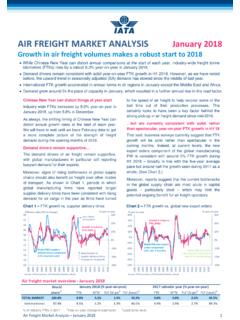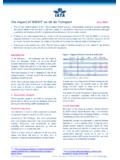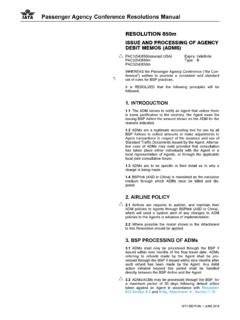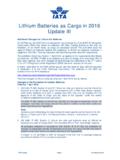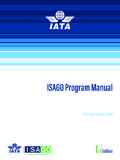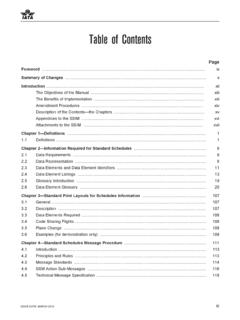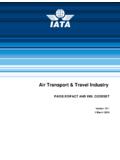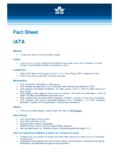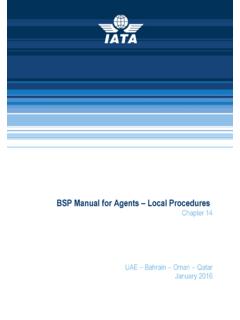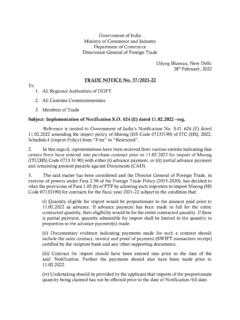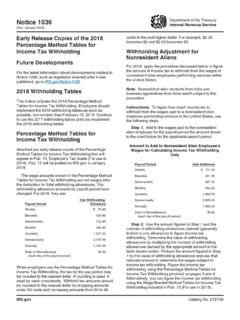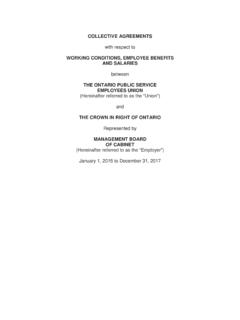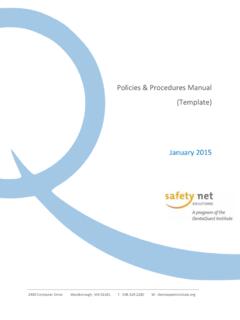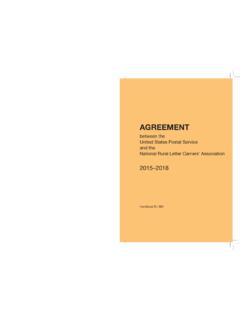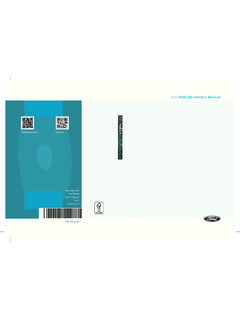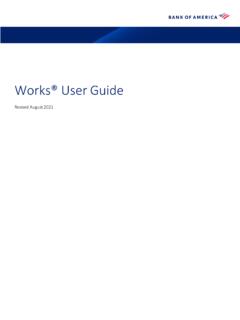Transcription of IATA Sustainable Aviation Fuel Roadmap
1 iata Sustainable Aviation fuel Roadmap1stEditionIATA Sustainable Aviation fuel RoadmapISBN 978-92-9252-704-4 2015 International Air Transport Association. All rights GenevaNOTICEDISCLAIMER. The information contained in this publication is subject to constant review in the light of changing government requirements and regulations. No subscriber or other reader should act on the basis of any such information without referring to applicable laws and regulations and/or without taking appropriate professional advice. Although every effort has been made to ensure accuracy, the International Air Transport Association shall not be held responsible for any loss or damage caused by errors, omissions, misprints or misinterpretation of the contents hereof. Furthermore, the International Air Transport Association expressly disclaims any and all liability to any person or entity, whether a purchaser of this publication or not, in respect of anything done or omitted, and the consequences of anything done or omitted, by any such person or entity in reliance on the contents of this publication.
2 International Air Transport Association. All Rights Reserved. No part of this publication may be reproduced, recast, reformatted or transmitted in any form by any means, electronic or mechanical, including photocopying, recording or any information storage and retrieval system, without the prior written permission from:Senior Vice PresidentMember & External Relations and Corporate SecretaryInternational Air Transport Association33, Route de l A roport1215 Geneva 15 AirportSwitzerland 1st Edition 2015 i Table of Content List of Figures .. v List of Tables .. vi Foreword ..vii Executive Summary ..viii Section 1 Introduction .. 1 Background and Aim of the Roadmap .. 1 Industry Commitments .. 2 Section 2 Timeline .. 4 Introduction .. 4 Test Flights .. 5 Certification .. 5 Commercial Flights .. 7 Multi-stakeholder Sustainable Aviation fuel Initiatives .. 9 Airline/ fuel Supplier Collaboration.
3 12 Airport SAF Supply ..13 National and Industry Targets ..15 Supply and Demand Evolution ..16 Political and Economic Perspectives ..17 Long-term Developments ..18 Section 3 Technical and Economic Background ..21 Technology Pathways and Cost Expectations ..21 Fischer-Tropsch (FT) ..21 Synthesized Iso-Paraffins from Hydroprocessed Fermented Sugars (SIP) ..22 Cost Expectations of Technology Pathways ..22 Availability and Economics of Feedstock Worldwide ..23 Wood and Forestry Residues ..24 Agricultural Biomass ..25 Algae ..26 Wastes and Residues ..26 Cost Expectations of Feedstock ..27 SAF Efficiencies and Associated Lifecycle iata Sustainable Aviation fuel Roadmap ii 1st Edition 2015 SAF Supply Chain .. 29 Biojet fuel Price .. 29 Evolution of Fossil Jet fuel Price .. 30 Price Forecast .. 30 Links between the Prices of Biofuels and Food .. 31 Differences, Competition and Synergies with the Road Transport Biofuels Industry.
4 31 Differences .. 31 Synergies and Competition .. 32 iata s Role in the Commercialization and Deployment of SAF .. 33 Section 4 Sustainability Assessment and Proposals for Harmonization .. 34 Introduction .. 34 Overview of Legislation on Biofuels .. 34 Introduction .. 34 Overview of Some National and Regional Initiatives .. 34 European Union (EU) .. 35 United States (US) .. 37 39 Australia .. 39 Comparison between the RED and RFS .. 40 Similarities between the Standards .. 40 Differences between the Standards .. 41 Overview and Comparison of Relevant Voluntary 44 Voluntary Scheme Selection .. 44 Review of Selected Voluntary Schemes .. 45 Comparison of Key Aspects of Voluntary Schemes .. 45 Development of Proposals for Harmonization .. 48 Setting the Sustainability Ambition Level .. 48 Harmonization Options .. 49 Mutual Recognition between RED and RFS2 for Aviation .. 49 Meta-standard for SAF .. 51 Policy options.
5 53 Meta-standard for Aviation Biofuels .. 53 Mutual Recognition between RED and RFS2 for Aviation .. 54 Section 5 Accounting for SAF .. 55 Introduction .. 55 Design of the Global Market-based Measure .. 55 Chain of Custody Approach .. 56 Table of Content 1st Edition 2015 iii Overview of Design Choices for the Accounting System ..57 Control Point ..58 Airport or Airline Level Reporting ..59 Central Registry or Verification at the fuel System Level ..61 Limit on Percentage of Biojet fuel Reported ..62 Timeframe ..64 Policy Options ..66 Section 6 Economics and Effective Policy ..69 Introduction ..69 Policy Instruments Incentivizing Deployment of SAF ..69 Economic Instruments ..70 Command and Control Instruments ..71 Co-regulation Instruments ..72 Voluntary Initiatives and Collaborative Instruments ..72 Inventory of Existing Biofuel Policy Instruments around the World ..73 Policy Actions ..74 Section 7 Financing Models.
6 75 Background ..75 Investment in Fossil Fossil Jet fuel and Price Forecast ..75 Population Assumptions ..76 Potential SAF Funding Concepts ..76 Background ..77 Cost Benefit Analysis Overview ..77 Potential Biojet fuel Cost-benefit Analysis Examples ..79 Airline Demand ..82 Standard Intermediary Floating Purchase Agreement ..82 Infrastructure Funding Section 8 Success Stories and the Opportunity ..84 Overview ..84 United / British Airways / Solena ..85 SkyNRG Green Lane Program ..85 iata Sustainable Aviation fuel Roadmap iv 1st Edition 2015 Total / Amyris .. 85 Cathay / Fulcrum .. 86 Section 9 87 Appendix: Key Features of Selected Voluntary Sustainability Schemes .. 89 1. 2 BSvs .. 89 2. Bonsucro EU .. 91 3. ISCC EU .. 93 4. RSB EU 96 5. RSPO-RED .. 99 Glossary .. 102 Acronyms .. 104 List of Figures 1st Edition 2015 v List of Figures Figure 1. Alternative fuels flight tests between 2008 and 2013.
7 5 Figure 2. Past and future ASTM certifications of SAF production pathways .. 6 Figure 3. Source: ICAO ..11 Figure 4. Mapping of worldwide initiatives (based on announcements recorded in GFAAF - not meant to be exhaustive mainly initiatives since 2013) ..12 Figure 5. Current bioport projects ..14 Figure 6. Sum of current airline intentions, engagements and forecasts for the use of SAF. Note this chart is not intended to predict the assessment of the AFTF fuel production assessment task force..16 Figure 7. Contributions to the Aviation industry's high-level emissions reduction goals (schematic) ..20 Figure 8. Key (potential) biomass resources and regions for the production of advanced SAF. Source; SKYNRG (2012) ..23 Figure 9. Technical wood fuel potentials in year 2020. Source: DBFZ (2011) ..24 Figure 10. Technical fuel potential of straw during the period 2003-2007. Source: DBFZ (2011) ..25 Figure 11. Technical fuel potential of agricultural biomass in year 2020.
8 Source: DBFZ (2011) ..26 Figure 12. Well to Wing emissions different jet fuel production pathways (gCO2/MJ), including renewable options. Source: White paper on SAF; Prof. Dr. Andr Faaij (Copernicus Institute, Utrecht University) & Maarten van Dijk (SkyNRG) ..28 Figure 13. Supply chain cycle of SAF. Source: ATAG ..29 Figure 14. Evolution of jet fuel price since 2004..30 Figure 15. HEFA production possibilities (output as a % of input weight). Source: MASBI (2013) ..32 Figure 16. Overview comparing the sustainability requirements of the national legislation and voluntary schemes under Figure 17. Mutual recognition between RED and RFS2 for Aviation option ..50 Figure 18. Hypothetical Meta-standard option met using voluntary schemes showing sustainability criteria requirements for Bronze, Silver and Gold level ..51 Figure 19. Meta-standard option met using independent audit showing sustainability criteria requirements for Bronze, Silver and Gold Figure 20.
9 Hybrid mass balance / book and claim accounting system ..57 Figure 21. Accounting system design ..60 iata Sustainable Aviation fuel Roadmap vi 1st Edition 2015 List of Tables Table 1. Commercial flights powered by SAF .. 8 Table 2. Multi-stakeholder Sustainable Aviation fuel initiatives .. 9 Table 3. Airline offtake agreements .. 13 Table 4. Targets set by states and industry for SAF fuel implementation .. 15 Table 5. Variables influencing feedstock, logistics and pre-processing costs .. 27 Table 6. Greenhouse gas emissions of SAF. Source: E4 Tech (2009) .. 28 Table 7. Overview of legalization and SAF initiatives .. 34 Table 8. Comparison of voluntary schemes key aspects .. 45 Table 9. Pros and Cons of mutual recognition between the RED and RFS2 .. 50 Table 10. Pros and Cons of a meta-standard for SAF .. 53 Table 11. Overview of SAF accounting system design choices .. 66 Table 12. Overview of the 2 BSvs voluntary scheme .. 89 Table 13. Overview of the Bonsucro EU voluntary scheme.
10 91 Table 14. Overview of the ISCC EU voluntary scheme .. 94 Table 15. Overview of the RSB EU RED voluntary scheme .. 97 Table 16. Overview of the RSPO-RED voluntary scheme .. 99 1st Edition 2015 vii Foreword In 2015 , over 3 billion passengers will have boarded an aircraft somewhere on the planet. There are many factors that drive Aviation demand, from holidays to business or visiting friends and relatives, not to mention the need for the speedy transportation of perishable and high value goods to which we have grown so accustomed. And demand for Aviation is not slowing. In fact, it is forecast that passenger demand will increase globally by approximately 5% per annum in the medium term. While this translates into a tremendous economic opportunity, it also exposes the rising challenge of growing in a Sustainable manner. iata member airlines cover around 85% of all commercial flight operations.
